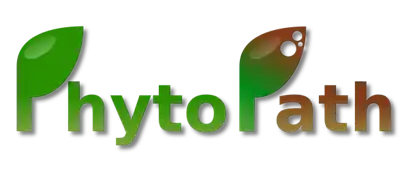PhytoPath
PhytoPath is a joint scientific project between the European Bioinformatics Institute and Rothamsted Research. The project aims to enable the exploitation of the growing body of “-omics” data being generated for phytopathogens, their plant hosts and related model species. Gene mutant phenotypic information is directly displayed in genome browsers.
 | |
|---|---|
| Content | |
| Description | The PhytoPath project collects and integrates genome-scale data from important fungal, oomycete and bacterial plant pathogens with literature-curated information on mutant phenotypes. Data are displayed using the Ensembl Genomes platform. |
| Data types captured | Genome-scale data, phenotypes of microbial mutants |
| Organisms | 88 fungal, 24 bacterial and 23 protist pathogens |
| Contact | |
| Research center | EMBL-EBI and Rothamsted Research |
| Primary citation | PMID 26476449 |
| Release date | 2012 |
| Access | |
| Data format | FASTA, GFF3 |
| Website | PhytoPath |
| Tools | |
| Web | PhytoPath BioMart search |
| Miscellaneous | |
| License | Apache 2.0 software license |
| Versioning | Yes |
| Data release frequency | quarterly |
| Version | PhytoPath is built from 32nd release (Aug 2016) of Ensembl Genomes and version 4.2 of PHI-base |
Background
PhytoPath is a bioinformatics resource launched in 2012, which integrates genome scale data from important plant pathogenic species with literature-curated information about the phenotypes of host infection available from the Pathogen-Host Interaction database (PHI-base). It provides access to complete genome assembly and gene models from priority crop and model phytopathogenic species of fungi and oomycetes through the Ensembl Genomes Browser interface. Phytopath also links directly from individual gene sequence models within the Ensembl genome browser to the peer reviewed phenotype information curated within PHI-base. The Phytopath resource aims to provide tools for comparative analysis of fungal and oomycete genomes. In 2015 the database makes accessible 135 genomic sequences in genome browsers from 87 plant pathogen species. For 1364 genes phenotypic annotation regarding their role in pathogenicity or as targets for chemical intervention is displayed directly in the pathogen genome browser. Support for community annotation for gene models is provided using the WebApollo online gene editor for some species.
External links
References
- Pedro, H.; Maheswari, U.; Urban, M.; Irvine, A.G.; Cuzick, A.; Mcdowall, M.D.; Staines, D.M.; Kulesha, E.; Hammond-Kosack, K.E.; Kersey, P.J. (2016). "PhytoPath: an integrative resource for plant pathogen genomics". Nucleic Acids Research. 44: D688-639. doi:10.1093/nar/gkv1052. PMC 4702788. PMID 26476449.
- Flicek; et al. (2011). "Ensembl 2011". Nucleic Acids Res. 39: D800–6. doi:10.1093/nar/gkq1064. PMC 3013672. PMID 21045057.
- Winnenburg, R.; Urban, M.; Beacham, A.; Baldwin, T.K.; Holland, S.; Lindeberg, M.; Hansen, H.; Rawlings, C.; Hammond-Kosack, K.; Köhler, J. (2008). "PHI-base update: additions to the pathogen host interactions database". Nucleic Acids Research. 36: D572–6. doi:10.1093/nar/gkm858. PMC 2238852. PMID 17942425.
- Baldwin, T.K.; Winnenburg, R.; Urban, M.; Rawlings, C.; Köhler, J.; Hammond-Kosack, K.E. (2006). "The Pathogen-Host Interactions database (PHI-base) provides insights into generic and novel themes of pathogenicity". Molecular Plant-Microbe Interactions. 19 (12): 1451–62. doi:10.1094/mpmi-19-1451. PMID 17153929.